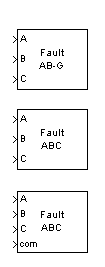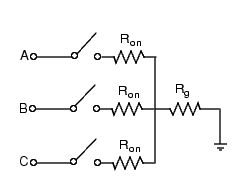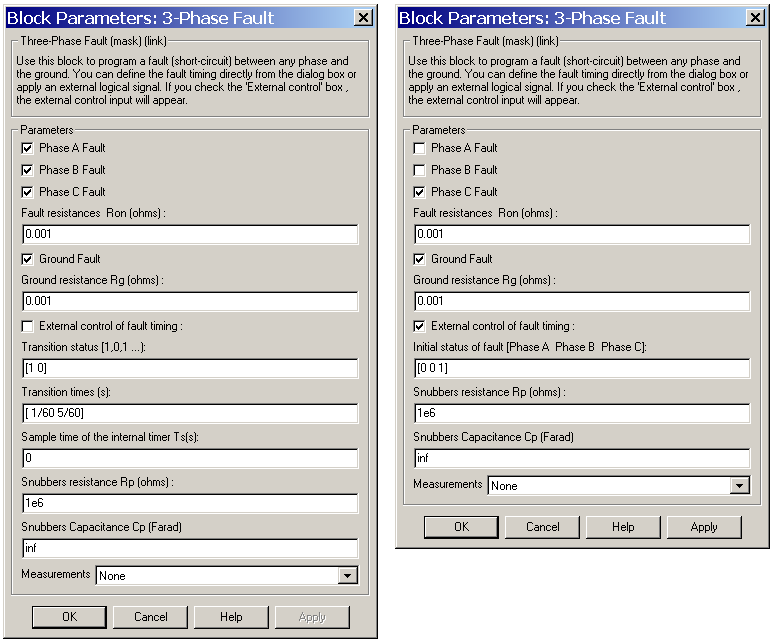| SimPowerSystems |
  |
3-Phase Fault
Implement a programmable phase-to-phase and phase-to-ground fault breaker system
Library
Extras/Three-Phase Library
Description

The 3-Phase Fault block implements a three-phase circuit breaker where the opening and closing times can be controlled either from an external Simulink signal (external control mode), or from an internal control timer (internal control mode).
The 3-Phase Fault block uses three Breaker blocks that can be individually switched on and off to program phase-to-phase faults, phase-to-ground faults, or a combination of phase-to-phase and ground faults.

The ground resistance Rg is automatically set to 1e6 ohms when the ground fault option is not programmed. For example, to program a fault between the phases A and B you need to check the Phase A Fault and Phase B Fault block parameters only. To program a fault between the phase A and the ground, you need to check the Phase A Fault and Ground Fault parameters and specify a small value for the ground resistance.
If the 3-Phase Fault block is set in external control mode, a control input appears in the block icon. The control signal connected to the fourth input must be either 0 or 1, 0 to open the breakers, 1 to close them. If the 3-Phase Fault block is set in internal control mode, the switching times and status are specified in the dialog box of the block.
Series Rs-Cs snubber circuits are included in the model. They can be optionally connected to the fault breakers. If the 3-Phase Fault block happen to be in series with an inductive circuit, an open circuit or a current source, you must use the snubbers.
Dialog Box and Parameters

- Phase A Fault
- If selected, the fault switching of phase A is activated. If not selected, the breaker of phase A stays in its initial status. The initial status of the phase A fault breaker is specified by the Transition status parameter when the 3-Phase Fault block is used in internal control mode. It is specified by the Initial status of fault parameter when the block is used in external control mode.
- Phase B Fault
- If selected, the fault switching of phase B is activated. If not selected, the breaker of phase B stays in its initial status. The initial status of the phase B fault breaker is specified by the Transition status parameter when the 3-Phase Fault block is used in internal control mode. It is specified by the Initial status of fault parameter when the block is used in external control mode.
- Phase C Fault
- If selected, the fault switching of phase C is activated. If not selected, the breaker of phase C stays in its initial status. The initial status of the phase C fault breaker is specified by the Transition status parameter when the 3-Phase Fault block is used in internal control mode. It is specified by the Initial status of fault parameter when the block is used in external control mode.
- Fault resistances Ron (ohms):
- The internal resistance, in ohms (
 ), of the phase fault breakers. The Fault resistance Ron parameter cannot be set to 0.
), of the phase fault breakers. The Fault resistance Ron parameter cannot be set to 0.
- Ground Fault
- If selected, the fault switching to the ground is activated. A fault to the ground can be programed for the activated phases. For example if the Phase C Fault and Ground Fault parameters are selected, a fault to the ground is applied to the phase C. The ground resistance is set internally to 1e6 ohms when the Ground Fault parameter is not selected.
- Ground resistance Rg (ohms):
- The ground resistance, in ohms (
 ). The Ground resistance Rg (ohms) parameter cannot be set to 0. The Ground resistance Rg (ohms) parameter is not visible if the Ground Fault parameter is not selected.
). The Ground resistance Rg (ohms) parameter cannot be set to 0. The Ground resistance Rg (ohms) parameter is not visible if the Ground Fault parameter is not selected.
- External control of fault timing:
- If selected, adds a fourth input port to the 3-Phase Fault block for an external control of the switching times of the fault breakers. The switching times are defined by a Simulink signal (
0 or 1) connected to the fourth input port of the block.
- Transition status:
- Specify the vector of switching status when using the 3-Phase Breaker block in internal control mode. The selected fault breakers opens (0) or closes (1) at each transition time according to the Transition status parameter values.
- If the first value specified in the Transition times parameter is 0, the initial status of the fault breakers corresponds to the first value specified in the vector of switching status (0 for open, 1 for closed). Otherwise the initial status of the breakers corresponds to the complement of the first value specified in the vector of switching status.
- Transition times (s)
- Specify the vector of switching times when using the 3-Phase Breaker block in internal control mode. At each transition time the selected fault breakers opens or closes depending to the initial state. The Transition times (s) parameter is not visible in the dialog box if the External control of switching times parameter is selected.
- Sample time of the internal timer Ts (s)
- The sample time of the internal breakers. The default is 0, corresponding to continuous breaker models.
- Initial status of fault [Phase A Phase B Phase C]
- The initial status of the fault breakers when the 3-Phase Fault block is used in external control mode.
- Snubbers resistance Rp (ohms)
- The snubber resistances, in ohms (
 ). Set the Snubber resistance Rp parameter to
). Set the Snubber resistance Rp parameter to inf to eliminate the snubbers from the model.
- Snubbers Capacitance Cp (Farad)
- The snubber capacitances, in farads (F). Set the Snubber capacitance Cp parameter to
0 to eliminate the snubbers, or to inf to get resistive snubbers.
- Measurements
- Select Fault voltages to measure the voltage across the three internal fault breaker terminals.
- Select Fault currents to measure the current flowing through the three internal breakers. If the snubber devices are connected, the measured currents are the ones flowing through the breakers contacts only.
- Select Fault voltages and currents to measure the breaker voltages and the breaker currents.
- Place a Multimeter block in your model to display the selected measurements during the simulation. In the Available Measurements list box of the Multimeter block, the measurements is identified by a label followed by the block name and the phase:
Measurement
|
Label
|
Fault voltages
|
Ub <block name> /Fault A: Ub <block name> /Fault B: Ub <block name> /Fault C.
|
Fault currents
|
Ib <block name> /Fault A: Ib <block name> /Fault B: Ib <block name> /Fault C.
|
Inputs and Outputs
The inputs 1, 2, and 3 are the breaker terminals. The breakers are connected between inputs 1, 2, and 3 and the internal ground resistor. If the 3-Phase Fault block is set in external control mode, input 4 appears and is used to control the opening and closing of the three internal breakers.
Example
See the psb3phseriescomp.mdl circuit for a demo using the 3-Phase Fault block.
See also
Breaker, 3-Phase Breaker
 | 3-Phase Dynamic Load | | 3-Phase Programmable Voltage Source |  |






 ), of the phase fault breakers. The Fault resistance Ron parameter cannot be set to 0.
), of the phase fault breakers. The Fault resistance Ron parameter cannot be set to 0. ). The Ground resistance Rg (ohms) parameter cannot be set to 0. The Ground resistance Rg (ohms) parameter is not visible if the Ground Fault parameter is not selected.
). The Ground resistance Rg (ohms) parameter cannot be set to 0. The Ground resistance Rg (ohms) parameter is not visible if the Ground Fault parameter is not selected.  ). Set the Snubber resistance Rp parameter to
). Set the Snubber resistance Rp parameter to 
